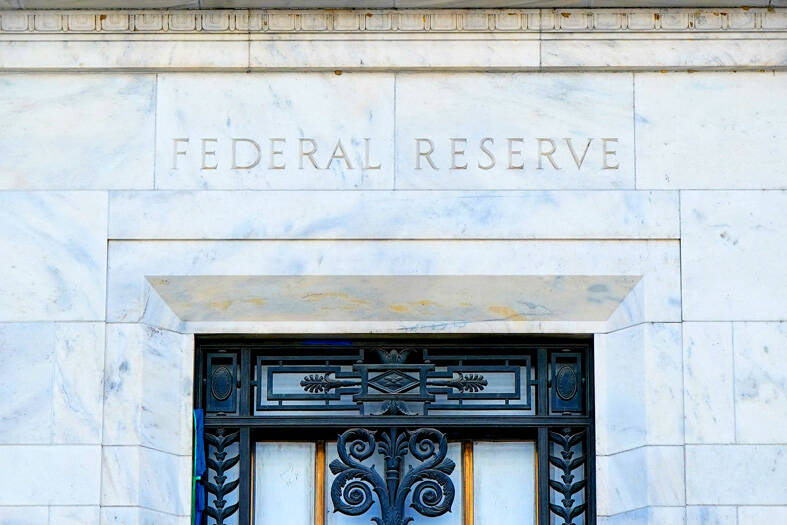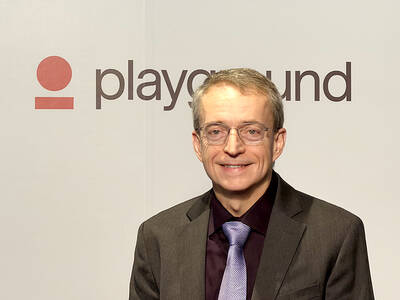Division at the US Federal Reserve has intensified in the past few weeks, with officials staking out disparate positions ahead of the central bank’s policy meeting next month — all while Fed Chair Jerome Powell stays silent.
The drama was amped up on Friday when New York Fed President John Williams, sometimes seen as a proxy for the Fed chief, signaled his support for a rate cut after several other policymakers came out leaning against one.
Powell himself has not spoken publicly since the central bank’s last rate decision on Oct. 29, but a tally of recent remarks suggests the other voting members of the rate-setting Federal Open Market Committee (FOMC) are nearly evenly split over what to do, all but ensuring some would vote against the Dec. 10 decision regardless of the outcome.

Photo: Reuters
Once a rarity under Powell, dissents have increased this year. As officials wrestled with competing objectives of supporting a flagging labor market and keeping inflation in check, there has not been a unanimous vote since June. The US government shutdown, which delayed several key economic data releases, further complicated their ability to agree on which goal to prioritize.
The Fed has long prided itself on making rate decisions by consensus, and it has been a hallmark of Powell’s tenure at the helm, which began in 2018 and is set to conclude in May next year.
The resulting low number of dissenting votes at the Fed’s eight annual policy meetings telegraphs confidence in their decisions, and some research suggests it ensures clear and effective communication of the committee’s intentions. However, critics argue it also leads to “group-think” that suppresses potentially important arguments.
“On the group-think thing, people who are accusing us of this, get ready. You might see the least group-think you’ve seen from the FOMC in a long time,” Fed Governor Christopher Waller said on Monday.
Waller dissented from the Fed’s decision to hold rates steady in July along with his colleague Michelle Bowman — the first time two Fed governors had voted against the chair in 32 years.
At the following meeting in mid-September, Fed Governor Stephen Miran — who joined the Fed board that month after being nominated by US President Donald Trump — voted against his colleagues’ decision to lower rates by a quarter point, instead favoring a bigger rate reduction.
At the Fed’s Oct. 28-29 meeting, Miran dissented again for the same reason, while Kansas City Fed President Jeff Schmid dissented in the opposite direction. Schmid wanted to hold rates steady, arguing that further cuts could reignite inflation.
That is a sentiment that has been expressed by more Fed policymakers in the weeks since. Five of the 12 officials who vote on policy this year have indicated they are leaning toward keeping rates on hold next month.
“We need to be careful and cautious now about monetary policy,” Fed Governor Michael Barr, who in the past has leaned toward providing support for the labor market, said last week.
Other past doves have also indicated they might be more comfortable holding rates steady next month. They include Chicago Fed President Austan Goolsbee, who has not dissented in his nearly three years at the Fed, but said he would if he felt like he needed to.
“If I end up feeling strongly one way, and it’s different from what everybody else thinks, then that’s what it is. That’s fine. I think that’s healthy,” Goolsbee said on Thursday in a call with reporters. “I don’t think there’s anything wrong with dissenting.”
He acknowledged there have been more dissents this year than in recent Fed history, but also called that healthy.

The number of Taiwanese working in the US rose to a record high of 137,000 last year, driven largely by Taiwan Semiconductor Manufacturing Co’s (TSMC, 台積電) rapid overseas expansion, according to government data released yesterday. A total of 666,000 Taiwanese nationals were employed abroad last year, an increase of 45,000 from 2023 and the highest level since the COVID-19 pandemic, data from the Directorate-General of Budget, Accounting and Statistics (DGBAS) showed. Overseas employment had steadily increased between 2009 and 2019, peaking at 739,000, before plunging to 319,000 in 2021 amid US-China trade tensions, global supply chain shifts, reshoring by Taiwanese companies and

Taiwan Semiconductor Manufacturing Co (TSMC, 台積電) received about NT$147 billion (US$4.71 billion) in subsidies from the US, Japanese, German and Chinese governments over the past two years for its global expansion. Financial data compiled by the world’s largest contract chipmaker showed the company secured NT$4.77 billion in subsidies from the governments in the third quarter, bringing the total for the first three quarters of the year to about NT$71.9 billion. Along with the NT$75.16 billion in financial aid TSMC received last year, the chipmaker obtained NT$147 billion in subsidies in almost two years, the data showed. The subsidies received by its subsidiaries —

Shiina Ito has had fewer Chinese customers at her Tokyo jewelry shop since Beijing issued a travel warning in the wake of a diplomatic spat, but she said she was not concerned. A souring of Tokyo-Beijing relations this month, following remarks by Japanese Prime Minister Sanae Takaichi about Taiwan, has fueled concerns about the impact on the ritzy boutiques, noodle joints and hotels where holidaymakers spend their cash. However, businesses in Tokyo largely shrugged off any anxiety. “Since there are fewer Chinese customers, it’s become a bit easier for Japanese shoppers to visit, so our sales haven’t really dropped,” Ito

OUTLOOK: Pat Gelsinger said he did not expect the heavy AI infrastructure investments by the major cloud service providers to cause an AI bubble to burst soon Building a resilient energy supply chain is crucial for Taiwan to develop artificial intelligence (AI) technology and grow its economy, former Intel Corp chief executive officer Pat Gelsinger said yesterday. Gelsinger, now a general partner at the US venture capital firm Playground Global LLC, was asked at a news conference in Taipei about his views on Taiwan’s hardware development and growing concern over an AI bubble. “Today, the greatest issue in Taiwan isn’t even in the software or in architecture. It is energy,” Gelsinger said. “You are not in the position to have a resilient energy supply chain, and that,